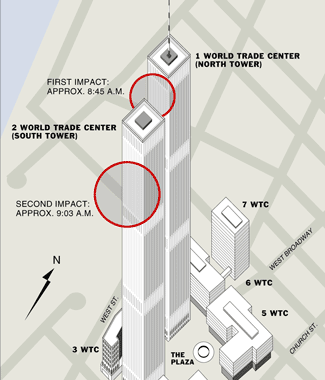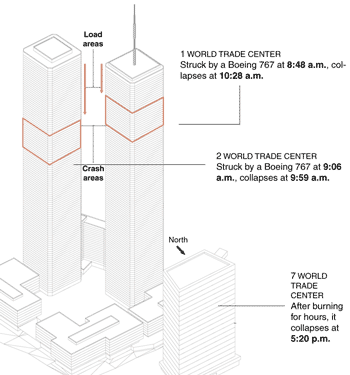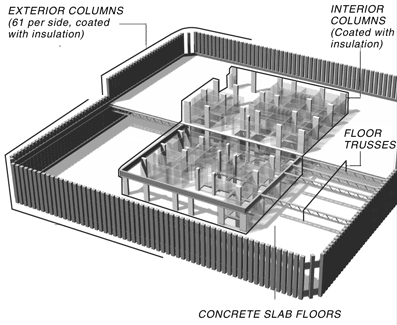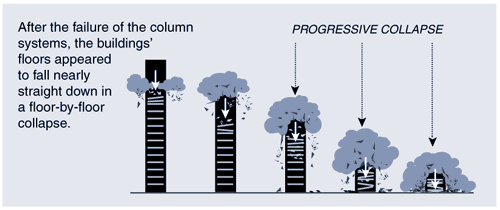| STRUCTURAL DETAILS OF THE WORLD TRADE CENTRE
TOWERS The twin towers, framed
in structural steel, had exterior moment frames with
14-in. steel box columns spaced 39 in. centers. The
configuration created a complete tube around the
building. The central steel core carried gravity loads
only. The exterior tube provided all the lateral
resistance. Horizontal steel trusses spanned 60 ft from
the exterior wall to the core. Concrete on metal deck
completed the floor diaphragm.
The twin towers were part of a
seven-building complex designed by architect Minoru
Yamasaki that covers eight city blocks. An 800 x 400-ft
foundation box, 65-ft-deep and with 3-ft-thick retaining
walls, is under more than half the complex, including the
twin towers and the adjacent hotel. The complex was
completed in phases beginning in 1970 (ENR 7/9/64 p. 36).
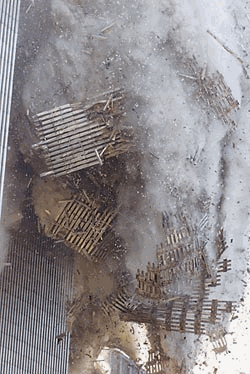
World Trade Center
Collapsing (AP Photo)
Each tower contained about 100,000 tons of steel and 4
in. of concrete topping on the 40,000-sq-ft floors,
according to Henry H. Deutch, assistant to the chief
structural engineer for construction manager Tishman
Realty & Construction Co. Inc., New York City, during
the construction of the WTC and currently head of HHD
Consultants Inc., Osceola County, Fla.
Deutch says that originally, the north
tower contained asbestos in its cementitious fireproofing
as did the first 30 stories of the south tower. He
believes the asbestos, which had been encapsulated, was
removed after the 1993 bombing. In a press conference,
Mayor Rudolph W. Giuliani said the city's health
department had tested the air in the area and found no
undue amount of chemical agents.
Millions across the nation also "saw" the
towers collapse, through live television news coverage.
The south tower fell at 10 a.m. and the north tower at
10:29 a.m.
Reports indicate that the impact of each plane
compromised the structural integrity of each tower,
knocking out perimeter columns and the interior
structure. The explosions then caused further damage,
sweeping through several floors. "These were
airliners scheduled for long flights, full of fuel,
causing massive explosions," says Richard M. Kielar,
a Tishman senior vice president. "No structure could
have sustained this kind of assault," says Kielar.
As the fires burned, the structural steel on the breached
floors and above would have softened and warped because
of the intense heat, say sources. Fireproofed steel is
only rated to resist 1,500 to 1,600° F. As the structure
warped and weakened at the top of each tower, the frame,
along with concrete slabs, furniture, file cabinets, and
other materials, became an enormous, consolidated weight
that eventually crushed the lower portions of the frame
below.
Jon D. Magnusson, chairman-CEO of Skilling Ward Magnusson
Barkshire Inc., Seattle, structural engineer for the
original World Trade Center, agrees: "From what I
observed on TV, it appeared that the floor diaphragm,
necessary to brace the exterior columns, had lost
connection to the exterior wall."
When the stability was lost, the exterior columns buckled
outward, allowing the floors above to drop down onto
floors below, overloading and failing each one as it went
down, he says.
A big question for implosion expert Mark Loizeaux,
president of Controlled Demolition Inc., the Phoenix,
Md., is why the twin towers appeared to have collapsed in
such different ways. Observing the collapses on
television news, Loizeaux says the 1,362-ft-tall south
tower, which was hit at about the 60th floor, failed much
as one would like fell a tree. That is what was expected,
says Loizeaux. But the 1,368-ft-tall north tower,
similarly hit but at about the 90th floor,
"telescoped," says Loizeaux. It failed
vertically, he adds, rather than falling over. "I
don't have a clue," says Loizeaux, regarding the
cause of the telescoping.
Security measures were tightened at the 12-million-sq-ft
WTC complex after a terrorist bomb on Feb. 26, 1993. That
bomb blew out one section of a north tower basement
X-brace between two of the perimeter columns. The blast
ripped out sections of three structural slabs in the
basement levels between the north tower and the hotel,
threatening the structural integrity of the foundation
box. It did little damage to the north tower's structural
tube, other than the affected X-brace. Damage was
extensive to the other building systems, however, because
the bomb compromised major utility lines in the basement,
and the brace compromised the central core wall, allowing
soot and smoke to shoot up the building core (ENR 3/15/93
p. 12).
CLICK here for more: Structural
engineers say the terrorists apparently knew they had to
strike the World Trade Center as low as possible to cause
the most damage & Facts about the World Trade
Center
|
